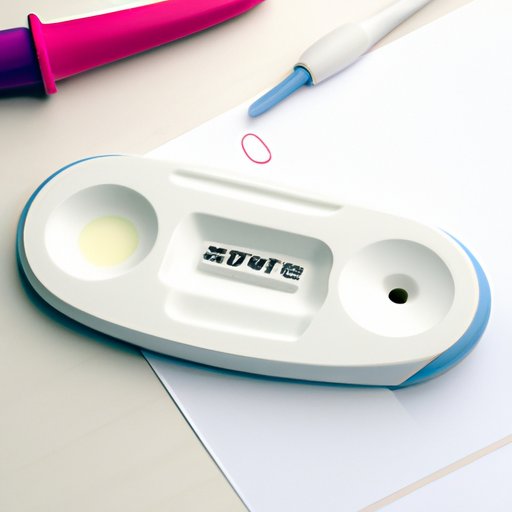Introduction
Trying to conceive can be both exciting and nerve-wracking. Many couples struggle with infertility and are eager to find out what steps they can take to increase their chances of getting pregnant. One of the most important things to know is when to take an ovulation test.
An ovulation test determines when a woman is most likely to get pregnant. It works by detecting the levels of luteinizing hormone (LH) in a woman’s body. This hormone is released by the pituitary gland just before ovulation, which is when the egg is released from the ovary. Knowing when this hormone is at its peak can help couples time intercourse for the highest chance of conception.
This article will explore the benefits of taking an ovulation test at the optimal time and provide an explanation of how to determine the best time to take it. Additionally, it will discuss key factors that affect when to take an ovulation test, as well as why timing matters and how to maximize your chances with an ovulation test.

Key Factors That Affect When to Take an Ovulation Test
There are several factors to consider when determining when to take an ovulation test. These include factors related to your biological cycle and factors related to your health.
Factors Related to Your Biological Cycle
The length of your menstrual cycle is a key factor in determining when to take an ovulation test. Most women have cycles that range between 21 and 35 days. The average cycle is 28 days, but some women may have longer or shorter cycles depending on their individual biology. Knowing the duration of your cycle can help you determine when to take the test.
It is also important to note that ovulation typically occurs in the middle of your cycle, 12 to 16 days before your next period begins. Knowing where you are in your cycle can help you determine when to take the test.
Factors Related to Your Health
Your health can also affect when to take an ovulation test. Certain medications, such as hormonal birth control pills, can affect your cycle and make it difficult to accurately predict when you will ovulate. Additionally, certain medical conditions, such as polycystic ovarian syndrome, can also cause irregularities in your cycle.
If you are taking any medications or have any medical conditions that may affect your cycle, it is important to consult your doctor before attempting to use an ovulation test.
Why Timing Matters: A Guide to Using Ovulation Tests
Knowing when to take an ovulation test is essential in order to maximize your chances of conceiving. Here is a guide to using ovulation tests.
Maximizing Your Chances with an Ovulation Test
The first step in maximizing your chances with an ovulation test is to purchase a quality product. Make sure to buy a test that is approved by the FDA and has been tested for accuracy. Additionally, read the instructions carefully to ensure that you are using the test correctly.
Once you have purchased a quality test, you can begin to monitor your cycle. To do this, start by keeping track of your cycle length and noting when your period begins and ends. Then, count the days until you expect to ovulate. This is typically 12 to 16 days before your next period. Once you have determined when you expect to ovulate, you can begin testing.
Making the Most of Your Ovulation Test
Once you have determined when to take the test, it is important to make the most of it. Start by taking the test first thing in the morning. This will give you the most accurate results as your LH levels tend to be highest in the morning. Additionally, it is important to take the test every day during your fertile window. This will help you identify your peak fertility window and maximize your chances of conception.
Knowing When to Take an Ovulation Test for Maximum Accuracy
Once you have taken the test, it is important to interpret the results correctly. Most ovulation tests come with a color chart that indicates the level of LH in your body. If the test is positive, this indicates that your LH levels are high and that you are likely to ovulate soon. If the test is negative, this indicates that your LH levels are low and that you are not likely to ovulate soon.
It is important to remember that ovulation tests are not 100% accurate. False positives can occur if your LH levels are elevated for other reasons, such as stress or illness. Additionally, false negatives can occur if your LH levels are lower than usual. If you have any doubts, it is best to speak to your doctor.
Conclusion
Knowing when to take an ovulation test can significantly increase your chances of getting pregnant. Taking the test at the optimal time will allow you to accurately determine when you are most fertile and maximize your chances of conception. In order to determine when to take the test, it is important to consider key factors related to your biological cycle and health. Additionally, it is important to understand how to use an ovulation test correctly and interpret the results accurately.
By understanding the benefits of taking an ovulation test at the optimal time, key factors that affect when to take an ovulation test, and how to maximize accuracy, couples can increase their chances of conceiving and have a better chance of achieving their dream of starting a family.


